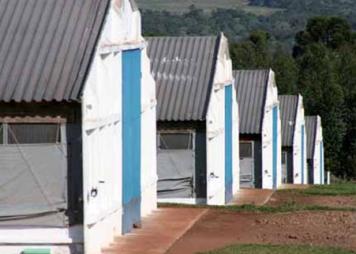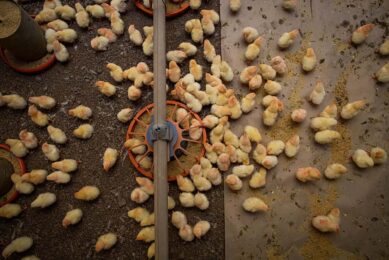Brazil’s poultry industry begins to recover

Starved of export credits and battling with falling prices, Brazil’s poultry industry has experienced a dramatic six months. However, the worst may be over.
By Patrick Knight, Sao Paulo, Brazil
For Brazil, the world’s third largest and for the past five years the leading poultry exporter, the past six months have been some of the most dramatic for the poultry industry. Almost 20% less was exported between November 2008 and February 2009 as in the same period a year earlier as export credits dried up and demand weakened. Additionally, prices have fallen sharply.
To avoid a build-up of large stocks, almost 20% fewer chicks have been lodged in the past few months as before November last year. As well as operational difficulties, some companies have been hit hard as hedging operations went sour following the 30% devaluation of the Brazilian currency. As a result, a series of mergers and acquisitions can be expected.
A record of over 300,000 tonnes of whole birds, cuts and processed meat was exported each month during the first 10 months of 2008, when 11 million tonnes was produced and 3.64 million tonnes exported – 9% more than in 2007. With demand buoyant, prices rose above US$2,000 per tonne in July, 20% higher than the 2007 average. However, as the crisis intensified, prices began to fall to a low of US$1,124 per tonne in February, at a time when 120,000 less was exported as in May last year, and when 360,000 tonnes were shipped.
Two big players
The combination of lower prices and reduced volumes resulted in monthly export earnings falling from US$700 million in August 2008, to less than US$300 million in February this year. The steady rise in prices, which began in early 2006, was partly explained by the fact that the Brazilian currency, the Real, gained ground steadily against the US dollar, as well as other currencies, for several years. Producers raised prices to compensate. This was possible because the world economy was booming, while the price of oil that was produced in a dozen countries, which between them buy almost half Brazil’s chicken exports, was rising fast.
However, the crisis caused hard currency to flood out of Brazil in 2008, and as a result, the Real fell about 30% against the US dollar in a few weeks. The oil price collapsed and following the failure of the Lehman Bros bank in mid September, credit lines that financed exports dried up almost completely.
Not only did the crisis cause prices and shipments to fall, but it also caused severe financial damage to some of the country’s leading exporters, notably Sadia, responsible for about a quarter of all the meat exported from Brazil in recent years. Like many other Brazilian companies, Sadia resorted to hedging operations to protect its earnings from the impact caused by the steady rise in the Real. In the beginning, hedging covered just a few months’ exports. However, as the Real continued to rise, what turned out to be a very profitable activity encouraged companies to hedge up to a year’s exports. In some years the profits from hedging allowed Sadia to make a substantial profit when a loss would otherwise have occurred. When the Real finally collapsed, however, a tough contract exposed Sadia to huge losses. The company recorded a loss of over US$1 billion in 2008, with a further US$1 billion to be repaid to creditors before September 2009.
It recently became certain that a badly weakened Sadia will now merge with Brazil’s second largest exporter, Perdigao, which Sadia attempted to buy two years ago. Sadia is largely owned by members of two families, and Perdigao by pension funds. The resulting company, named Brasil Foods, will be responsible for more than half of all of Brazil’s exports.
Fewer chicks lodged
The Brazilian industry was anxious to avoid a repeat of the events of early 2006, when concerns that avian influenza might spread all over the world very rapidly and possibly to humans as well. This resulted in demand and prices to fall sharply. Processors were obliged to divert thousands of tonnes of poultry meat earmarked for export to the domestic market where it was sold at a low price. This time, the Brazilian Poultry Union, UBA, told processors to cut chick lodgings by 20% as soon as possible. Due to an average of 10% more poultry meat produced each year for the past 20 years, chick producers found it difficult to accept that a cut of this size was unavoidable.
However, leading integrated processors sent fewer chicks to contracted farmers and re-stocked farms less frequently than usual. Companies laid off up to 20% of their staff at processing plants until supply was closer to demand.
Following these drastic measures, less than 800,000 tonnes of poultry meat was produced in February. This is compared with a peak of virtually a million tonnes in November 2008 and the 900,000 tonnes produced in each of the preceding eight months.
Although Brazilian poultry meat is now sold to more than 200 countries, just 10 are responsible for two thirds of sales. Slightly more than 30% goes to the Middle East, notably to Saudi Arabia, the United Arab Emirates and Kuwait. Until recently, consumers in this region bought almost exclusively whole birds, most of them 1kg “grillers”, but more cuts are now being sold, and although relatively little processed meat now goes to the Middle East, demand for such high value products is growing fast.
It remains to be seen what impact the fall in the price of crude oil will have on poultry meat sales to the region. Hundreds of thousands of workers from poor countries in the Indian sub-continent and Asia migrated to the region in recent years, many of who are now returning home. It is still not clear how long the price of crude oil will remain low, and how quickly demand will respond when an economic upturn begins, but sales to the Middle East seems unlikely to return to their previous peak until 2011, at the earliest.
Asia also important
Countries in Asia last year purchased 26% of poultry exports. Additionally, Japan and Hong Kong, the second and third most important customers for Brazilian poultry meat, bought almost 850,000 tonnes between them in 2008.
Japan has been hit hard by the downturn and bought 30% less in the past three months as in the first 10 months of 2008. Sales to Hong Kong, which re-exports most of what it imports to China, have been unaffected by the crisis, increasing slightly in the past few months.
After many years of negotiations, several Brazilian processing companies have been authorised to export directly to China, and shipments are expected to commence later this year. This will probably mean some of what is now sold to Hong Kong goes directly to China. The Brazilians anticipate that an extra 50,000 tonnes will go to the two countries this year and that China will soon emerge as Brazil’s leading customer for poultry meat.
Venezuela and Russia, Brazil’s fourth and eighth largest customers in 2008, have both been hit extremely hard by the collapse in the price of oil. Russia has long been an important customer for Brazilian poultry meat, as well as for pork and beef. Although the country aims to become self-sufficient in poultry, most analysts think that this will not happen for some time.
Heating costs are high, barns must be more robust than those in Brazil to keep out the cold, and Russia does not produce much feed, so chicken produced there will cost much more than that from Brazil. Sales to Russia fell sharply from the 13,500 monthly average of the first 10 months of 2008, to little more than 5,000 tonnes in December, although they have improved since. Shipments to Venezuela have fluctuated wildly and although 33,000 tonnes was imported in September, only 14,000 tonnes was bought in November and less than 5,000 tonnes in February, as importers had difficulty obtaining funds.
Gap narrowed
Shipments to the EU have fallen by about 20% since the crisis hit, as consumers there have cut back on a meat which, because it is subject to extremely high import duties, is relatively expensive. Brazilian exports of both beef and pork have been hit as hard as those of chicken, and to dispose of surpluses, prices of all meats have been lowered on the domestic market. Chicken remains the lowest cost meat in Brazil, but the gap between this protein and the cheapest cuts of beef and pork has narrowed.
Sales of processed goods, which now contribute up to three quarters of the domestic revenues of the largest exporters, who hardly bother to sell lower margin whole birds and basic cuts in Brazil, are showing signs of weakening.
After growing by more than 5% in each of the past two years, the Brazilian economy is not expected to grow at all this year. Close to a million workers, most of them in the industry, have lost their jobs. Many more are working part time, or their wages have been cut. With the crisis spreading to the much larger services sector, another million jobs are predicted to be lost this year.
Although people certainly continue eating, to suggest that demand for food is inelastic seems optimistic. The sudden reduction in exports was largely due to the sharp reduction in the availability of finance for exports. However, it is evident that many consumers are now buying less, or switching to lower cost items.
Interpreting these trends means estimating how much chicken will be produced this year in Brazil is extremely difficult. Optimists suggest that up to 400,000 tonnes more than last year’s 11 million tonnes will be needed. Others suggest that this year will see a repeat of last year’s output, still others suggest that up to half a million tonnes less will be produced this year as in 2008. The trend towards more food being consumed in the home, rather than at restaurants, may not mean less chicken is consumed. That, like much else, however, remains to be seen.
World Poultry Vol. 25 No. 6
Join 31,000+ subscribers
Subscribe to our newsletter to stay updated about all the need-to-know content in the poultry sector, three times a week. Beheer
Beheer








 WP Admin
WP Admin  Bewerk bericht
Bewerk bericht